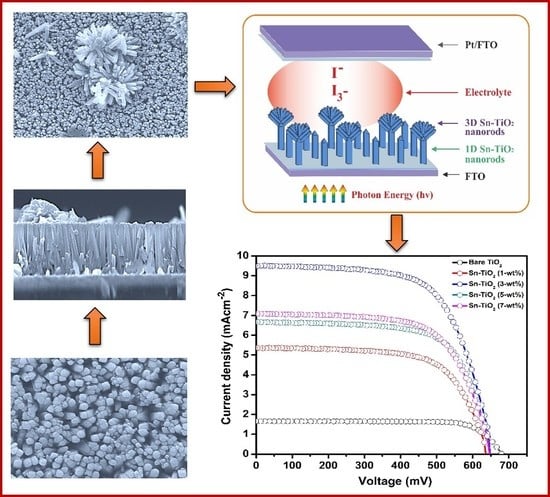Influence of Tin Doped TiO2 Nanorods on Dye Sensitized Solar Cells
Abstract
1. Introduction
2. Methods
2.1. Synthesis of Sn-Doped TiO2 Films
2.2. Cell Fabrication and Photovoltaic Measurements
2.3. Characterizations
3. Results and Discussion
4. Conclusions
Supplementary Materials
Author Contributions
Funding
Institutional Review Board Statement
Informed Consent Statement
Data Availability Statement
Acknowledgments
Conflicts of Interest
References
- Oelhafen, P.; Schüler, A. Nanostructured materials for solar energy conversion. Sol. Energy 2005, 79, 110–121. [Google Scholar] [CrossRef]
- O’ Regan, B.C.; Durrant, J.R. Kinetic and energetic paradigms for dye-sensitized solar cells: Moving from the ideal to the real. Acc. Chem. Res. 2009, 42, 1799–1808. [Google Scholar] [CrossRef]
- Zhang, S.; Yang, X.; Numata, Y.; Han, L. Highly efficient dye-sensitized solar cells: Progress and future challenges. Energy Environ. Sci. 2013, 6, 1443–1464. [Google Scholar] [CrossRef]
- Marimuthu, T.; Anandhan, N.; Thangamuthu, R.; Surya, S. Influence of solution viscosity on hydrothermally grown ZnO thin films for DSSC applications. Superlattices Microstruct. 2016, 98, 332–341. [Google Scholar] [CrossRef]
- Mali, S.S.; Betty, C.A.; Bhosale, P.N.; Patil, P.S. Eosin-Y and N3-Dye sensitized solar cells (DSSCs) based on novel nanocoral TiO2: A comparative study. Electrochim. Acta 2012, 59, 113–120. [Google Scholar] [CrossRef]
- Panetta, R.; Latini, A.; Pettiti, I.; Cavallo, C. Synthesis and characterization of Nb2O5mesostructures with tunable morphology and their application in dye-sensitized solar cells. Mater. Chem. Phys. 2017, 202, 289–301. [Google Scholar] [CrossRef]
- Qi, T.; Wang, Q.; Zhang, Y.; Wang, D.; Yang, R.; Zheng, W. Growth of flower-like SnO2 crystal and performance as photoanode in dye-sensitized solar cells. Mater. Des. 2016, 112, 436–441. [Google Scholar] [CrossRef]
- Akila, Y.; Muthukumarasamy, N.; Agilan, S.; Senthilarasu, S.; Velauthapillai, D. Zirconium oxide post treated tin doped TiO2 for dye sensitized solar cells. Mater. Sci. Semicon. Proc. 2017, 57, 24–31. [Google Scholar] [CrossRef]
- Changneng, Z.; Chen, S.; Mo, L.; Huang, Y.; Tian, H.; Hu, L.; Huo, Z.; Dai, S.; Kong, F.; Pan, X. Charge recombination and band-edge shift in the dye-sensitized Mg2+ doped TiO2 solar cells. J. Phys. Chem. C 2011, 115, 16418–16424. [Google Scholar]
- Mehraz, S.; Konsong, P.; Taleb, A.; Dokhane, N.; Sikong, L. Large scale and facile synthesis of Sn doped TiO2 aggregates using hydrothermal synthesis. Sol. Energy Mater. Sol. Cells 2019, 189, 254–262. [Google Scholar] [CrossRef]
- Liu, X.; Kong, W.; Zhao, G.; Xuan, J.; Zhao, Y.; Zhou, T.; Xiu, J.; Wang, J.; Sun, M.; Yin, G. Enhanced CdS quantum dots loading density and charge transport by Sn4+ doping improve the photoelectrochemical performance of TiO2 nanosheets with highly exposed {001} facets. Appl. Surf. Sci. 2019, 486, 28–36. [Google Scholar] [CrossRef]
- Duan, Y.; Fu, N.; Zhang, Q.; Fang, Y.; Zhou, X.; Lin, Y. Influence of Sn source on the performance of dye-sensitized solar cells based on Sn-doped TiO2 photoanodes: A strategy for choosing an appropriate doping source. Electrochim. Acta 2013, 107, 473–480. [Google Scholar] [CrossRef]
- Xiang, P.; Ma, W.; Xiao, T.; Jiang, L.; Tan, X.; Shu, T. Ta-doped hierarchical TiO2 spheres for dye-sensitized solar cells. J. Alloys. Compd. 2016, 656, 45–50. [Google Scholar] [CrossRef]
- Su, H.; Huang, Y.T.; Chang, Y.H.; Zhai, P.; Hau, N.Y.; Cheung, P.C.H.; Yeh, W.T.; Wei, T.C.; Feng, S.P. The Synthesis of Nb-doped TiO2 Nanoparticles for Improved-Performance Dye Sensitized Solar Cells. Electrochim. Acta 2015, 182, 230–237. [Google Scholar] [CrossRef]
- Wategaonkar, S.B.; Parale, V.G.; Pawar, R.P.; Mali, S.S.; Hong, C.K.; Powar, R.R.; Moholkar, A.V.; Park, H.H.; Sargar, B.M.; Mane, R.K. Structural, morphological, and optical studies of hydrothermally synthesized Nb-added TiO2 for DSSC application. Ceram. Int. 2021, 47, 22580–22592. [Google Scholar] [CrossRef]
- Arunachalam, A.; Dhanapandian, S.; Manoharan, C. Effect of Sn doping on the structural, optical and electrical properties of TiO2 films prepared by spray pyrolysis. Physica E 2016, 76, 35–36. [Google Scholar] [CrossRef]
- Dhanapandian, S.; Arunachalam, A.; Manoharan, C. Highly oriented and physical properties of sprayed anatase Sn-doped TiO2 thin films with an enhanced antibacterial activity. Appl. Nanosci. 2016, 6, 387–397. [Google Scholar] [CrossRef]
- Kadam, A.; Dhabbe, R.; Shin, D.; Garadkar, K.; Park, J. Sunlight driven high photocatalytic activity of Sn doped N-TiO2 nanoparticles synthesized by a microwave assisted method. Ceram. Int. 2017, 43, 5164–5172. [Google Scholar] [CrossRef]
- Mahanty, S.; Roy, S.; Sen, S. Effect of Sn doping on the structural and optical properties of sol–gel TiO2 thin films. J. Cryst. Growth 2014, 261, 77–81. [Google Scholar] [CrossRef]
- Tripathi, A.K.; Mathpal, M.C.; Kumar, P.; Singh, M.K.; Soler, M.A.G.; Agarwal, A. Structural, optical and photoconductivity of Sn and Mn doped TiO2 nanoparticles. J. Alloys. Compd. 2015, 622, 37–47. [Google Scholar] [CrossRef]
- Liao, Y.H.; Chang, Y.H.; Lin, T.H.; Chan, S.H.; Lee, K.M.; Hsu, K.H.; Hsu, J.F.; Wu, M.C. Boosting the power conversion efficiency of perovskite solar cells based on Sn doped TiO2 electron extraction layer via modification the TiO2 phase junction. Solar Energy 2020, 205, 390–398. [Google Scholar] [CrossRef]
- Yang, Y.; Li, H.; Zhao, H.; Qu, R.; Zhang, S.; Hu, W.; Yu, X.; Zhu, X.; Liu, S.; Zheng, C.; et al. Structure and crystal phase transition effect of Sn doping on anatase TiO2 for dichloromethane decomposition. J. Hazard. Mater. 2019, 371, 156–164. [Google Scholar] [CrossRef]
- Lee, D.K.; Kwon, S.H.; Ahn, J.H. Growth of rutile-TiO2 thin films via Sn doping and insertion of ultra-thin SnO2 interlayer by atomic layer deposition. Mater. Lett. 2019, 246, 1–4. [Google Scholar] [CrossRef]
- Jiang, H.B.; Xing, J.; Chen, Z.P.; Tian, F.; Cuan, Q.; Gong, X.Q.; Yang, H.G. Enhancing photocatalytic activity of Sn doped TiO2dominated with {1 0 5} facets. Catal. Today 2014, 225, 18–23. [Google Scholar] [CrossRef]
- Sayilkan, F.; Asilturk, M.; Tatar, P.; Kiraz, N.; Arpac, E.; Sayilkan, H. Photocatalytic performance of Sn-doped TiO2 nanostructured mono and double layer thin films for Malachite Green dye degradation under UV and vis-lights. J. Hazard. Mater. 2007, 144, 140–146. [Google Scholar] [CrossRef]
- Ranjitha, A.; Thambidurai, M.; Shini, F.; Muthukumarasamy, N.; Velauthapillai, D. Effect of doped TiO2 film as electron transport layer for inverted organic solar cell. Mater. Sci. Energy Technol. 2019, 2, 385–388. [Google Scholar] [CrossRef]
- Sengele, A.; Rober, D.; Keller, N.; Colbeau-Justi, C.; Kellera, V. Sn-doped and porogen-modified TiO2 photocatalyst for solar light elimination of sulfurediethyle as a model for chemical warfare agent. Appl. Catal. B Environ. 2019, 245, 279–289. [Google Scholar] [CrossRef]
- Rimoldi, L.; Pargoletti, E.; Meroni, D.; Falletta, E.; Cerrato, G.; Turco, F.; Cappelletti, G. Concurrent role of metal (Sn, Zn) and N species in enhancing the photocatalytic activity of TiO2 under solar light. Catal. Today 2018, 313, 40–46. [Google Scholar] [CrossRef]
- Benkara, S.; Zerkout, S.; Ghamri, H. Synthesis of Sn doped ZnO/TiO2 nanocomposite film and their application to H2 gas sensing properties. Mater. Sci. Semicon. Proc. 2013, 16, 1271–1279. [Google Scholar] [CrossRef]
- Zakrzewska, K.; Radecka, M.; Rekas, M. Effect of Nb, Cr, Sn additions on gas sensing properties of TiO2 thin films. Thin Solid Films 1997, 310, 161–166. [Google Scholar] [CrossRef]
- Lubke, M.; Johnson, I.; Makwana, N.M.; Brett, D.; Shearing, P.; Liu, Z.; Darr, J.A. High power TiO2 and high capacity Sn-doped TiO2 nanomaterial anodes for lithium-ion batteries. J. Power Sources 2015, 294, 94–102. [Google Scholar] [CrossRef]
- Kyeremateng, N.A.; Vacandio, F.; Sougrati, M.T.; Martinez, H.; Jumas, J.C.; Knauth, P.; Djenizian, T. Effect of Sn-doping on the electrochemical behaviour of TiO2 nanotubes as potential negative electrode materials for 3D Li-ion micro batteries. J. Power Sources 2013, 224, 269–277. [Google Scholar] [CrossRef]
- Ako, R.T.; Ekanayake, P.; Young, D.J.; Hobley, J.; Chellappan, V.; Tan, A.L.; Gorelik, S.; Subramanian, G.S.; Lim, C.M. Evaluation of surface energy state distribution and bulk defect concentration in DSSC photoanodes based on Sn, Fe, and Cu doped TiO2. Appl. Surf. Sci. 2015, 351, 950–961. [Google Scholar] [CrossRef]
- Ni, S.; Guo, F.; Wang, D.; Jiao, S.; Wang, J.; Zhang, Y.; Wang, B.; Feng, P.; Zhao, L. Modification of TiO2 Nanowire Arrays with Sn Doping as Photoanode for Highly Efficient Dye-Sensitized Solar Cells. Crystals 2019, 9, 113. [Google Scholar] [CrossRef]
- Li, J.; Xu, X.; Liu, X.; Yu, C.; Yan, D.; Sun, Z.; Pan, L. Sn doped TiO2 nanotube with oxygen vacancy for highly efficient visible light photocatalysis. J. Alloy. Compd. 2016, 679, 454–462. [Google Scholar] [CrossRef]
- Mayabadi, A.H.; Waman, V.S.; Kamble, M.M.; Ghosh, S.S.; Gabhale, B.B.; Rondiya, S.R.; Rokade, A.V.; Khadtare, S.S.; Sathe, V.G.; Pathan, H.M.; et al. Evolution of structural and optical properties of rutile TiO2 thin films synthesized at room temperature by chemical bath deposition method. J. Phys. Chem. Solids 2014, 75, 182–187. [Google Scholar] [CrossRef]
- Mali, S.S.; Betty, C.A.; Bhosale, P.N.; Patil, P.S. Hydrothermal synthesis of rutile TiO2 with hierarchical microspheres and their characterization. CrystEnggComm 2011, 13, 6349–6351. [Google Scholar] [CrossRef]
- Huang, B.X.; Tornatore, P.; Li, Y.S. IR and Raman spectroelectrochemical studies of corrosion films on tin. Electrochim. Acta 2000, 46, 671–679. [Google Scholar] [CrossRef]
- Tripathi, A.K.; Mathpal, M.C.; Kumar, P.; Agrahari, V.; Singh, M.K.; Mishra, S.K.; Ahmad, M.M.; Agarwal, A. Photoluminescence and photoconductivity of Ni doped titaniananoparticles. Adv. Mater. Lett. 2015, 6, 201–208. [Google Scholar] [CrossRef]
- Lin, W.; Zhang, Y.F.; Li, Y.; Ding, K.N.; Li, J.Q. Structural characterizations and electronic properties of Ti-doped SnO2 (110) surface: A first-principles study. J. Chem. Phys. 2006, 124, 054704. [Google Scholar] [CrossRef]
- Maragatha, J.; Rajendran, S.; Endo, T.; Karuppuchamy, S. Microwave synthesis of metal doped TiO2 for photocatalytic applications. J. Mater. Sci Mater. Electron. 2017, 28, 5281–5287. [Google Scholar] [CrossRef]
- Maira, A.J.; Coronado, J.M.; Augugliaro, V.; Yeung, K.L.; Conesa, J.C.; Soria, J. Fourier transform infrared study of the performance of nanostructured TiO2 particles for the photocatalytic oxidation of gaseous toluene. J. Catal. 2001, 202, 413–420. [Google Scholar] [CrossRef]
- Gu, D.; Zhu, Y.; Xu, Z.; Wang, N.; Zhang, C. Effects of ion doping on the optical properties of dye-sensitized solar cells. Adv. Mater. Phys. Chem. 2014, 4, 187. [Google Scholar] [CrossRef][Green Version]
- Wategaonkar, S.B.; Pawar, R.P.; Parale, V.G.; Nade, D.P.; Sargar, B.M.; Mane, R.K. Synthesis of rutile TiO2 nanostructures by single step hydrothermal route and its characterization. Mater. Today-Proc. 2020, 23, 444–451. [Google Scholar] [CrossRef]
- Sanjines, R.; Tang, H.; Berger, H.; Gozzo, F.; Margaritondo, G.; Levy, F. Electronic structure of anatase TiO2 oxide. J. Appl. Phys. 1994, 75, 2945–2951. [Google Scholar] [CrossRef]
- Li, J.; Zeng, H.C. Hollowing Sn-doped TiO2 nanospheres via Ostwald ripening. J. Am. Chem. Soc. 2007, 129, 15839–15847. [Google Scholar] [CrossRef] [PubMed]
- Kumar, M.; Bhatt, V.; Abhyankar, A.C.; Kim, J.; Kumar, A.; Patil, S.H.; Yun J., H. New insights towards strikingly improved room temperature ethanol sensing properties of p-type Ce-doped SnO2 sensors. Sci. Rep. 2018, 8, 8079. [Google Scholar] [CrossRef]
- Xia, W.; Wang, H.; Zeng, X.; Han, J.; Zhu, J.; Zhou, M.; Wu, S. High-efficiency photocatalytic activity of type II SnO/Sn3O4 heterostructures via interfacial charge transfer. CrystEngComm 2014, 16, 6841–6847. [Google Scholar] [CrossRef]
- Benedetti, J.E.; Gonçalves, A.D.; Formiga, A.L.; De Paoli, M.A.; Li, X.; Durrant, J.R.; Nogueira, A.F. A polymer gel electrolyte composed of a poly (ethylene oxide) copolymer and the influence of its composition on the dynamics and performance of dye-sensitized solar cells. J. Power Sources 2010, 195, 1246–1255. [Google Scholar] [CrossRef]
- Du, J.; Zhao, G.; Pang, H.; Qian, Y.; Liu, H.; Kang, D.J. A template method for synthesis of porous Sn-doped TiO2 monolith and its enhanced photocatalytic activity. Mater. Lett. 2013, 93, 419–422. [Google Scholar] [CrossRef]
- Liu, J.; Yang, H.; Tan, W.; Zhou, X.; Lin, Y. Photovoltaic performance improvement of dye-sensitized solar cells based on tantalum-doped TiO2 thin films. Electrochim. Acta 2010, 56, 396–400. [Google Scholar] [CrossRef]
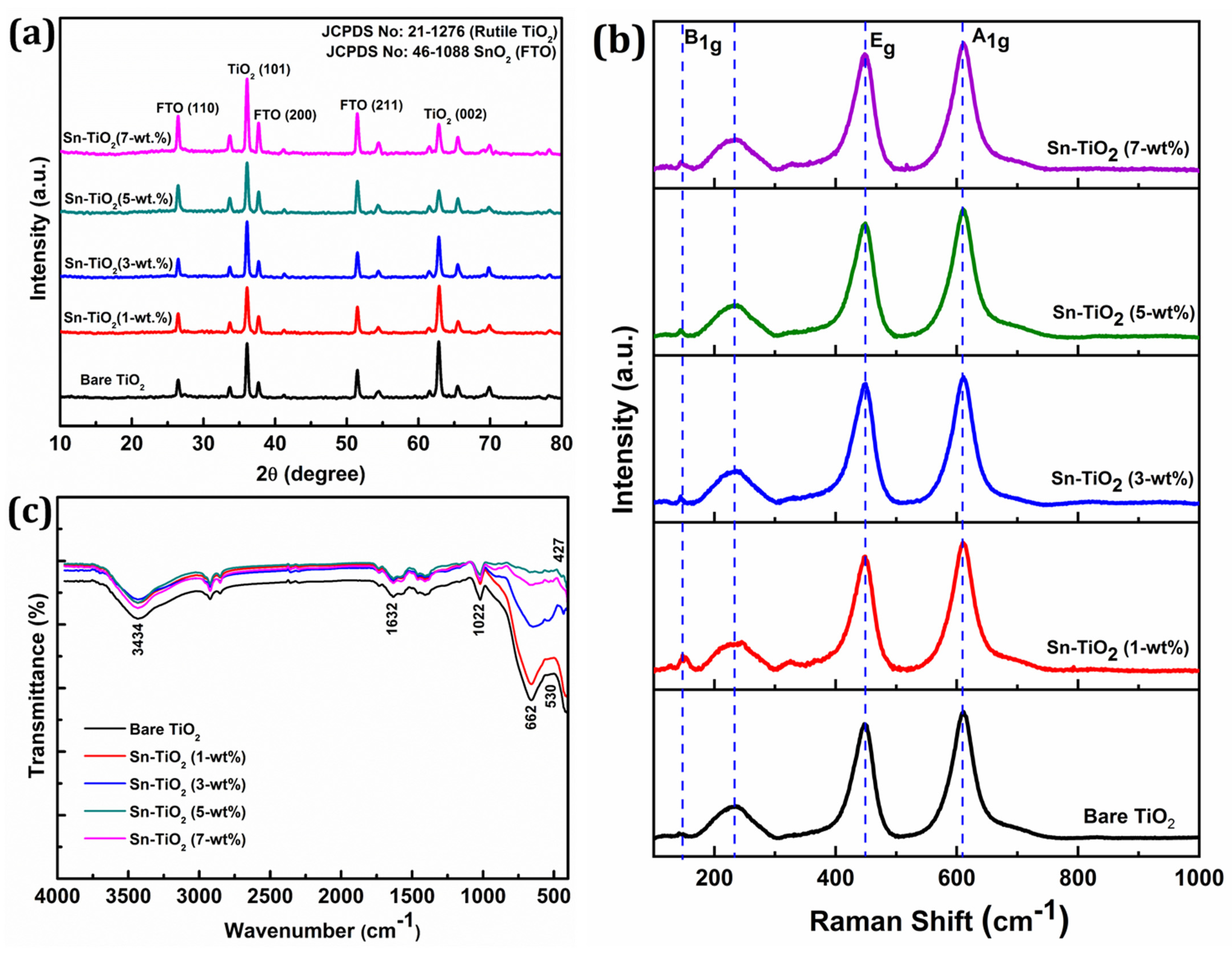
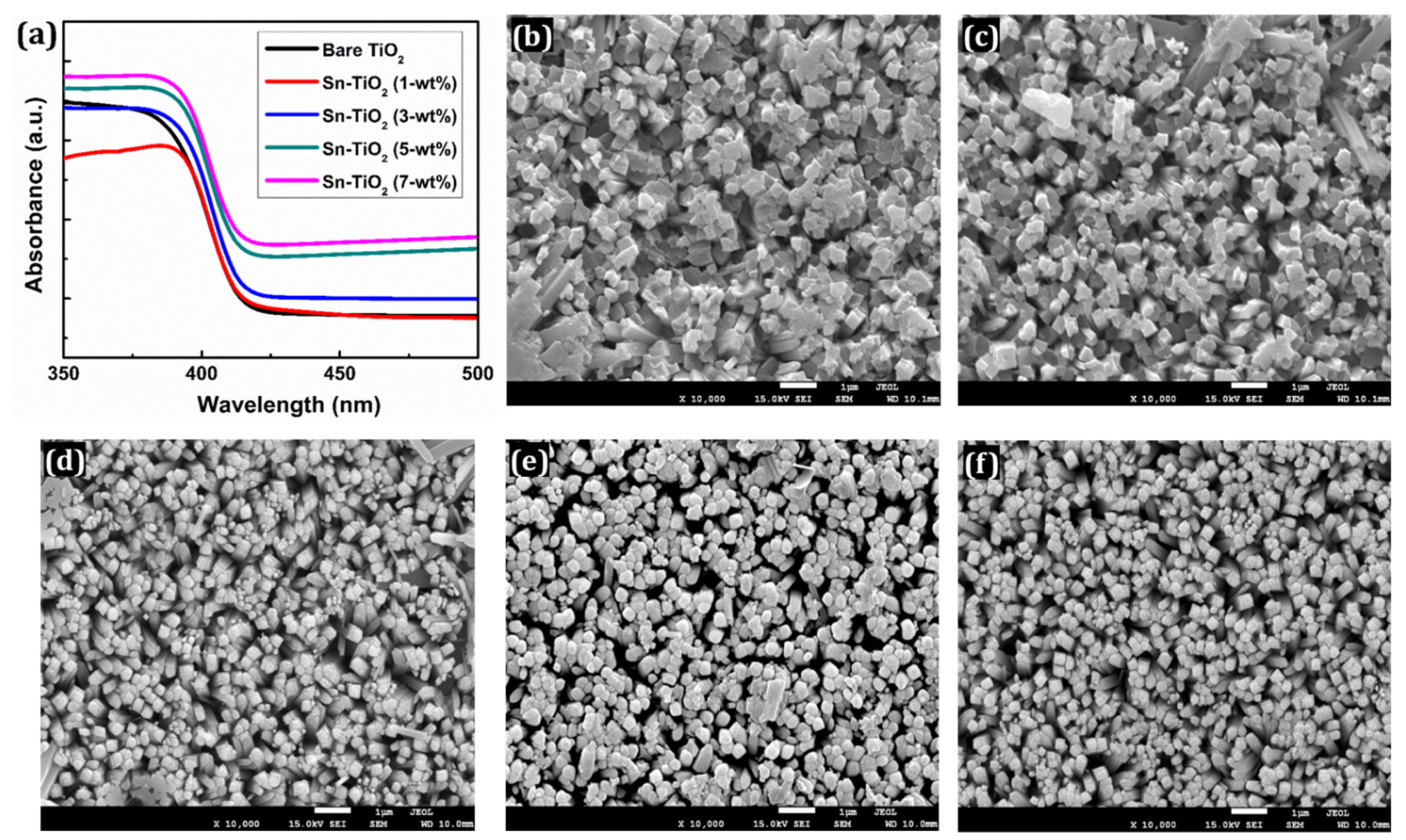

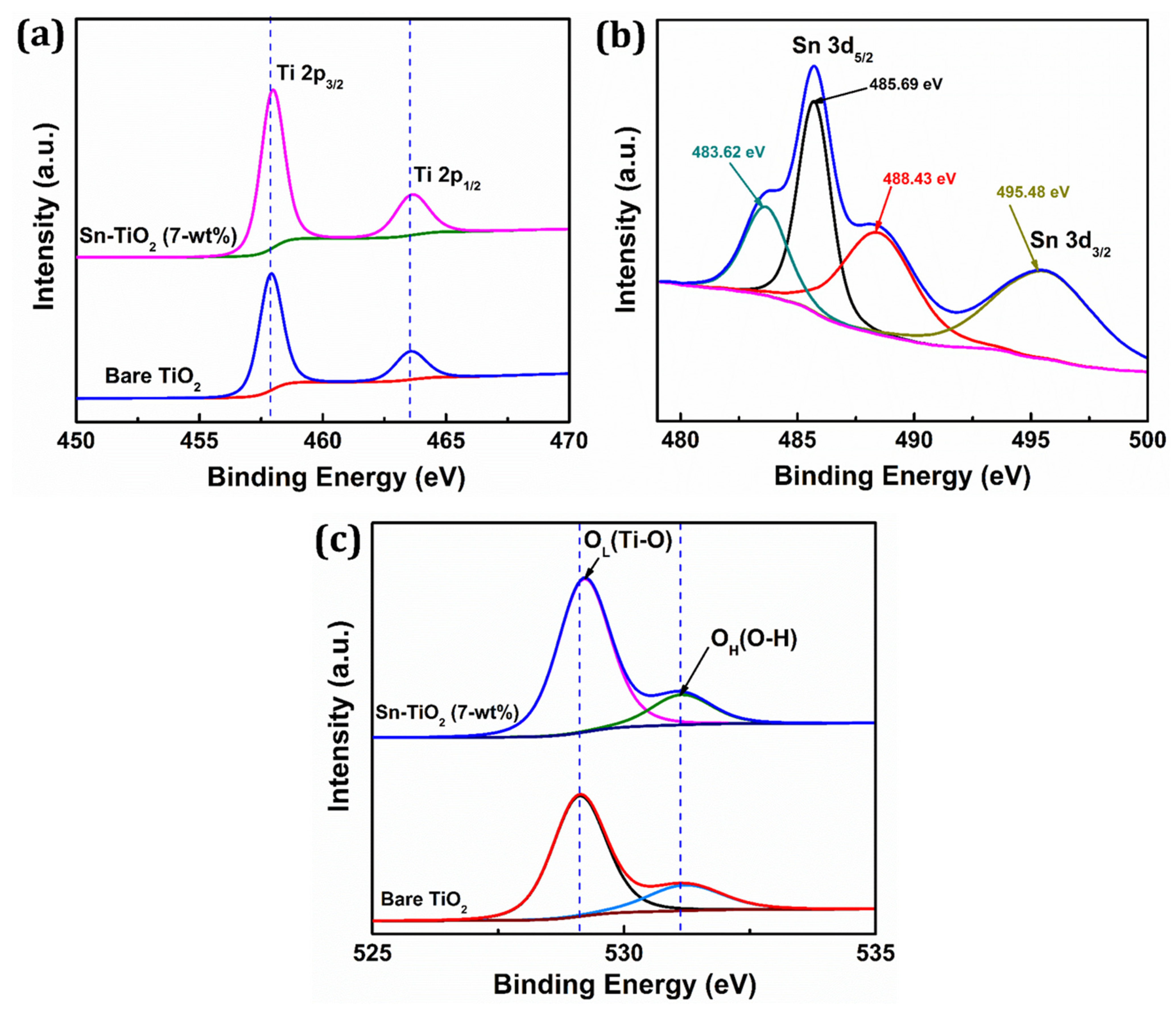
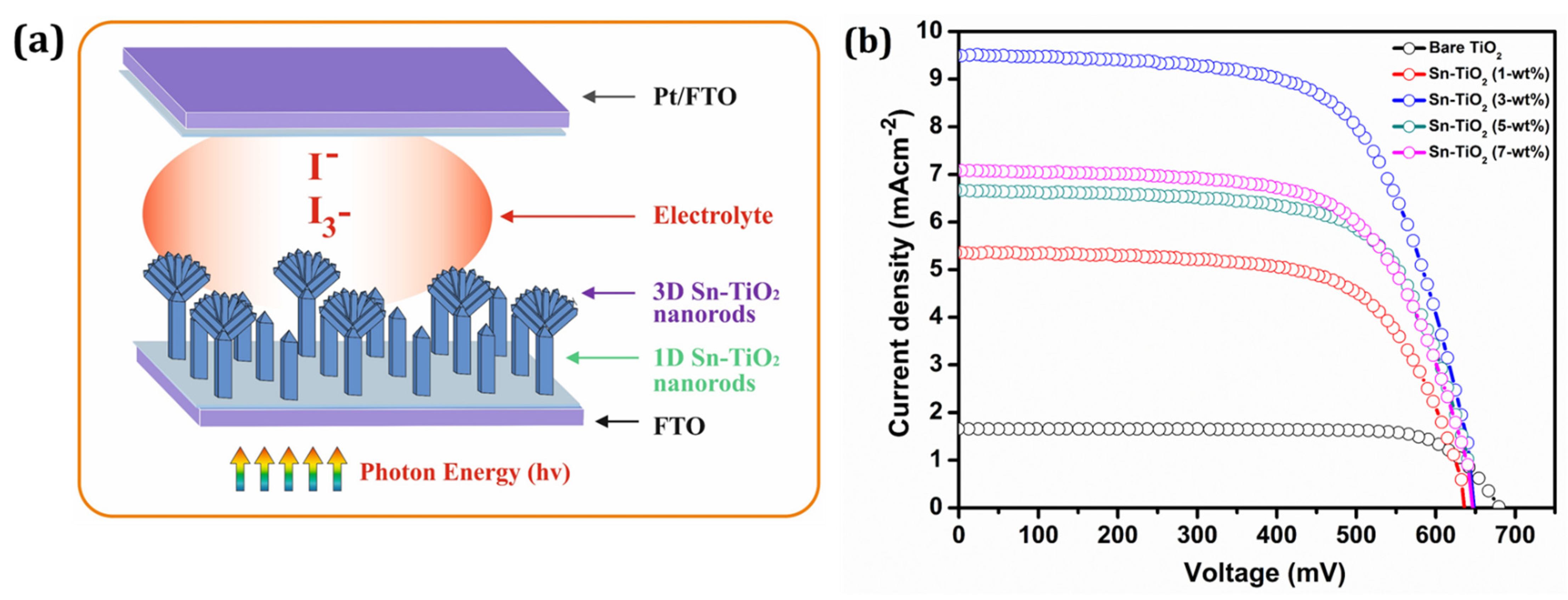
| Samples | Surface Area (m2 g−1) | Total Pore Volume (cm3 g−1) | Mean Pore Diameter (nm) |
|---|---|---|---|
| Bare TiO2 | 80.69 | 0.146 | 7.25 |
| Sn-TiO2 (1-wt %) | 84.11 | 0.165 | 7.86 |
| Sn-TiO2 (3-wt %) | 107.57 | 0.166 | 6.20 |
| Sn-TiO2 (5-wt %) | 88.88 | 0.181 | 8.16 |
| Sn-TiO2 (7-wt %) | 92.30 | 0.169 | 7.33 |
| DSSCs | Jsc (mA cm−2) | Voc (V) | FF (%) | Rsh Ω | Rs Ω | η (%) |
|---|---|---|---|---|---|---|
| Bare TiO2 | 1.65 | 0.68 | 77.70 | 355881 | 168.6 | 0.87 |
| Sn-TiO2 (1-wt %) | 5.35 | 0.63 | 66.43 | 11760 | 86.6 | 2.26 |
| Sn-TiO2 (3-wt %) | 9.49 | 0.64 | 65.29 | 8769 | 56.2 | 4.01 |
| Sn-TiO2 (5-wt %) | 6.66 | 0.64 | 68.17 | 12518 | 57.4 | 2.93 |
| Sn-TiO2 (7-wt %) | 7.08 | 0.64 | 65.64 | 10212 | 56.6 | 3.00 |
Publisher’s Note: MDPI stays neutral with regard to jurisdictional claims in published maps and institutional affiliations. |
© 2021 by the authors. Licensee MDPI, Basel, Switzerland. This article is an open access article distributed under the terms and conditions of the Creative Commons Attribution (CC BY) license (https://creativecommons.org/licenses/by/4.0/).
Share and Cite
Wategaonkar, S.B.; Parale, V.G.; Mali, S.S.; Hong, C.-K.; Pawar, R.P.; Maldar, P.S.; Moholkar, A.V.; Park, H.-H.; Sargar, B.M.; Mane, R.K. Influence of Tin Doped TiO2 Nanorods on Dye Sensitized Solar Cells. Materials 2021, 14, 6282. https://doi.org/10.3390/ma14216282
Wategaonkar SB, Parale VG, Mali SS, Hong C-K, Pawar RP, Maldar PS, Moholkar AV, Park H-H, Sargar BM, Mane RK. Influence of Tin Doped TiO2 Nanorods on Dye Sensitized Solar Cells. Materials. 2021; 14(21):6282. https://doi.org/10.3390/ma14216282
Chicago/Turabian StyleWategaonkar, Sandeep B., Vinayak G. Parale, Sawanta S. Mali, Chang-Kook Hong, Rani P. Pawar, Parvejha S. Maldar, Annasaheb V. Moholkar, Hyung-Ho Park, Balasaheb M. Sargar, and Raghunath K. Mane. 2021. "Influence of Tin Doped TiO2 Nanorods on Dye Sensitized Solar Cells" Materials 14, no. 21: 6282. https://doi.org/10.3390/ma14216282
APA StyleWategaonkar, S. B., Parale, V. G., Mali, S. S., Hong, C.-K., Pawar, R. P., Maldar, P. S., Moholkar, A. V., Park, H.-H., Sargar, B. M., & Mane, R. K. (2021). Influence of Tin Doped TiO2 Nanorods on Dye Sensitized Solar Cells. Materials, 14(21), 6282. https://doi.org/10.3390/ma14216282









